주머니 쥐. 유대목 주머니 쥐과
Opossum| Didelphidae[2] 시간 범위:초기 중신세 – Recent[1]PreꞒ Ꞓ OSDCPTJKPg N. | |
|---|---|
 | |
| 버지니아 주머니 쥐. 유대목 주머니 쥐과, 주머니 쥐 속 virginiana, 유일한 미국과 캐나다의 종(9 젊은 어머니). | |
| 과학적 분류 | |
| 왕국: | 동물계 |
| Phylum: | 코다타 |
| 클래스: | 포유류 |
| 인트라클라스: | 캥거루류. |
| Superorder: | 아메리델피아속 |
| 주문: | Didelphimorphia 길, 1872년 |
| 패밀리: | Didelphidae 그레이, 1821년 |
| 모식 속 | |
| 주머니 쥐 속 Linnaeus는 1758 | |
| Genera | |
| 몇몇;텍스트를 보 | |
| 다양성 | |
| 127종 | |
Didelphimorphia이 미국으로 풍토병(/daɪˌdɛlfɪˈmɔːrfiə/)유대류 주문의 Opossums(/əˈpɒsəm/)이다.유대류의 서반구에서 가장 큰 주문 19속에서 120+ 종들로 구성되어 있다.체 남 아메리카에 그레이트 아메리칸 인터체인지에서 북미와 남미의 연결에 이어북미에 시작되었다.
미국과 캐나다에서는 유일한 종이 발견된 버지니아 주머니 쥐.그것은 종종 단순히에 대한"주머니 쥐. 유대목 주머니 쥐과"로, 그리고 북 아메리카에서 그들은 일반적으로 possums[3](/pɒsəm/이다;가끔 서면 양식으로 'possums로 떨어졌다"제일의 것이다"을 표시에 바치)로 언급된다.그들은 아목 Phalangeriformes 또한"주머니 쥐"은 Didelphimorphia는 때문에라고 한다Australasian arboreal 주머니 모양의 혼동하지 않아야 한다.그 주머니 쥐. 유대목 주머니 쥐과는 일반적으로nonaggressive 동물이다.
어원
그 단어"주머니 쥐. 유대목 주머니 쥐과"은 포와탄 언어에 처음 1607년과 1611년 사이에 존 스미스(opassom로), 윌리엄 스트레 이치(aposoum로)로 기록되었다 인용하는.[4]Siebert 음소적으로 /a·passem/ 세계를 다시 생성합니다.[5]"쿠스 쿠스아목"처음으로 1613년에 기록되었습니다.둘 다 남자들은 제임스 타운 버지니아 주 스미스를 설립하기 위해, 스트레 이치 후에 그들의 첫번째 비서로 재직하고 있는 것을 도왔던 영국의 해결에 그 언어를 마주쳤다.[6]반면 있다고 스미스는 돼지처럼...쥐 꼬리 같은 머리 다 녹화된 스트레 이치의 노트는"돼지 꿈 커다람, 맛에서에서 똑같이 짐승"이 주머니 쥐. 유대목 주머니 쥐과의 묘사...고양이의 커다람 중에서."[6]포와하탄 단어는 궁극적으로 "흰 개 또는 개와 같은 짐승"을 의미하는 프로토 알곤퀴아어 단어(*wa·p-aememwa)에서 유래한다.[6]
유럽인들이 호주에 도착한 후, [7]캥거루와 같은 다른 호주의 유대류와 더 밀접하게 연관되어 있는 하위주문인 팔랑게르목의 멀리 연관되어 있는 호주의 유대류를 묘사하기 위해 "소유"라는 용어를 차용하였다.
그들은 비슷하게 두 개의 ("di") 자궁인 '디델피모르피아'를 가지고 있고, 두 번째는 비양자성 자궁(nursing-pouch)이다.[8]
진화
오포섬은 흔히 '살아있는 화석'[9]으로 여겨지고, 그 결과 비교연구에서 조상의 세리안의 상태를 대략적으로 추정하는 데 종종 사용된다.[9][10]그러나 가장 오래된 오포슘 화석은 초기 미오세네(거의 2천만년 전)에서 나온 것이기 때문에 이것은 부정확하다.[11]모든 살아있는 주머니쥐의 마지막 공통 조상은 대략적으로 올리고세-미오세 경계(2300만년 전)까지 거슬러 올라가며, 기껏해야 나이로는 올리고세보다 나이가 많지 않다.[12][13]한때 알파돈, 페라덱테스, 헤르페토테리움, 푸카델피스와 같이 초기 오포섬으로 여겨졌던 많은 멸종된 메타테리아인들은 그 이후 플레시오모르피스에 근거하여 이전에 오포섬과 함께 분류된 것으로 인정되어 현재는 현대 오포섬과 먼 거리에서만 관련된 메타테리아의 오래된 분지를 나타내는 것으로 간주되고 있다.
오포섬은 미오세네 후기까지 남아메리카 포유류 파우나의 작은 구성 요소였다.[12]이 시기 이전에는 현재 주머니쥐가 차지하고 있는 생태학적 틈새들은 바우키투베르쿨라탄과[14] 스파라소돈과[13][15][16] 같은 다른 메타테리아 그룹에 의해 점령되었다 디델피스와 같은 큰 주머니쥐들은 스파라소돈 다양성이 감소함에 따라 지질학적 시간에 걸쳐 점차적으로 크기가 커지는 패턴을 보인다.[15][16]틸로포롭스, 틸라테리듐, 하이퍼디델피스, 스파라시닌 등 여러 그룹의 오포섬은 남아메리카에 육식동물이 들어오기 전, 후기 미오세-플리오세 시대에 육식적응을 발달시켰다.루트렐리나를 제외한 이들 집단은 현재 대부분 멸종됐다.[17]
특성.
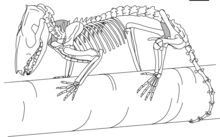
디델피모르프(Didelphimorphes)는 집고양이 크기로 자라는 소형에서 중형 유대류다.그들은 예외는 많지만 반 아르보랄 잡식성 동물인 경향이 있다.이 질서의 대부분의 구성원들은 긴 코빼기, 좁은 뇌경사, 그리고 두드러진 시상 볏을 가지고 있다.치과용 조제식은 5.1.3.44.1.3.4 × 2 = 50 톱니.포유류 기준으로 볼 때, 이것은 비정상적으로 꽉 찬 턱이다.근치는 매우 작고, 송곳니는 크고, 어금니는 삼첨판이다.
디델피모르프들은 식물성 자세(땅에 평평한 발)를 가지고 있고, 뒷발은 발톱이 없는 반대되는 숫자를 가지고 있다.몇몇 신세계 원숭이들처럼, 주머니쥐는 앞쪽 꼬리를 가지고 있다.모든 유대목 동물들처럼 털은 오직 돌로 이루어져 있고 암컷은 주머니를 가지고 있다.꼬리 부분과 발 부분에는 악취가 있다.위는 소박하고, 체가 작다.[9]대부분의 유대목 동물들처럼 수컷 오포섬은 쌍샘이 있는 갈림질된 페니스를 가지고 있다.[18][19][9]
비록 모든 살아있는 주머니쥐는 본질적으로 기회주의적 잡식동물이지만, 다른 종들은 그들이 식단에 포함하는 고기와 식물의 양에 따라 다양하다.Caluromyinae의 구성원들은 본질적으로 검소하지만, 루트린 오포섬과 파타고니아 오포섬은 주로 다른 동물들을 먹고 산다.[20]물주머니쥐나 야복(Chironectes minimus)은 물갈퀴를 이용해 민물 연체동물과 가재를 찾아 잠수하는 유일한 살아있는 반아큐피알이기 때문에 특히 특이하다.[21]멸종된 틸로포롭스는 4-7 kg으로 알려진 가장 큰 주머니쥐로, 마크로프레데이터였다.[22][23][24]대부분의 오팔십자는 나무나 지상의 생명에 잘 적응되어 있는 스캔이지만, 칼루로미니아와 글로니아이네이아류의 구성원들은 주로 수목류인 반면, 메타치바이러스, 모노델피스, 그리고 더 작은 정도 디델피스는 지상의 생명에 대한 적응력을 보여준다.[25]아마존 상류 유역에서 발견되는 메타바이러스 누디카우다투스는 과일 씨앗, 새나 파충류 같은 작은 척추동물, 가재나 달팽이 같은 무척추동물을 소비하지만 주로 식충성인 것으로 보인다.[26]
Reproduction 및 수명 주기
유대류로서 암컷 오포섬은 두 갈래로 갈라진 질, 분열된 자궁, 그리고 그녀의 주머니인 말수피움을 포함하는 생식 체계를 가지고 있다.[27]오포의 평균 발정 주기는 약 28일이다.[28]오포섬은 태반을 가지고 있지만 수명이 짧고 구조가 단순하며 태반 포유류와는 달리 완전한 기능을 발휘하지 못한다.[29][30]따라서 새끼들은 임신 기간이 다른 많은 작은 유대목 동물들의 임신 기간과 비슷하지만 12일에서 14일 밖에 되지 않는다.[31]그들은 20마리까지 새끼를 낳는다.[32]일단 태어나면, 자식은 찻잎을 잡고 간호하기 위해 말수피움으로 들어가는 길을 찾아야 한다.아기 주머니쥐는 호주 사촌들과 마찬가지로 조이스라고 불린다.[33]암컷 오보솜은 종종 매우 많은 수의 새끼를 낳는데, 이 중 대부분은 13마리나 되는 새끼들이 종에 따라 붙을 수 있고,[34] 따라서 살아남을 수 있다.새끼들은 젖을 뗀 지 70일에서 125일 사이에 젖을 뗀다.아포슘 수명은 보통 야생에서 1~2년 밖에 살지 못하고 사육된 지 4년 이상 되는 크기의 포유류에게 유별나게 짧다.노쇠는 빠르다.[35]
이 종은 보통 수컷이 암컷보다 약간 크고, 훨씬 무겁고, 큰 송곳니를 가지고 있는 등 성적으로 이형적인 편이다.[34]오포섬과 비수상 포유류의 가장 큰 차이점은 수컷의 두 갈래로 갈라진 음경과 암컷의 두 갈래로 갈라진 음부(didelphimorph)[36]라는 용어의 근원이다(이중 wombed를 의미하는 그리스어의 "didelphy"에서 유래했다).오포슘 정자조아는 정자-페어링을 나타내며, 경막외에서 결합 쌍을 형성한다.이것은 플라겔라 운동이 최대의 운동성을 위해 정확하게 조정될 수 있음을 보장할 수 있다.결합 쌍들은 수정하기 전에 분리된 정자조아로 분리된다.[37]
행동
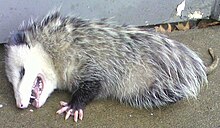
오포섬은 보통 혼자 있고 유목민으로, 음식과 물이 쉽게 구할 수 있는 한 한 한 지역에 머무른다.어떤 가족들은 이미 만들어진 굴이나 심지어 집 밑에서도 함께 모일 것이다.버려진 굴을 임시로 점유할 예정이지만 땅을 파거나 자체 건설에 많은 노력을 기울이지 않는다.야행성 동물로서, 그들은 어둡고 안전한 지역을 선호한다.이러한 지역은 지하 또는 그 이상일 수 있다.[38][39]
위협을 받거나 해를 입었을 때, 그들은 아프거나 죽은 동물의 겉모습과 냄새를 흉내내면서 "주머니쥐 놀이"를 할 것이다.이러한 생리적 반응은 의식적인 행동이라기보다는 무의식적으로(실신처럼) 기절하는 것이다.그러나 아기 주머니쥐의 경우 적절한 순간에 뇌가 항상 이런 식으로 반응하는 것은 아니므로 위협을 받을 때 '죽은 척'하지 못하는 경우가 많다.주머니쥐가 '주머니쥐 놀이'를 할 때 동물의 입술이 뒤로 당겨지고, 이빨이 벌려지며, 침이 입가에 번지고, 눈이 감긴다거나 반쯤 감긴다거나, 항문선으로부터 악취나는 액체가 분비된다.뻣뻣하고 웅크린 형태는 삐져나올 수 있고, 뒤집힐 수도 있고, 심지어 반응도 없이 떠내려갈 수도 있다.이 동물은 보통 몇 분에서 네 시간의 시간이 지나면 의식을 되찾게 되는데, 이 과정은 귀를 약간 경련하는 것으로 시작된다.[40]
어떤 종의 오포섬은 꼬리에 매달리는 것이 청소년들 사이에서 더 흔하지만, 꼬리에 매달리는 것은 예리한 꼬리를 가지고 있다.오포섬은 등반할 때 꼬리를 가새와 다섯 번째 팔다리로서 사용할 수도 있다.꼬리는 때때로 나뭇잎 뭉치나 침구 재료를 둥지로 옮기는 그립으로 사용된다.[41]어머니는 가끔 새끼를 등에 업고 올라가거나 달릴 때도 새끼가 꼭 달라붙는다.
위협받는 관상동맥(특히 수컷)이 깊게 으르렁거려 위협이 급박해질수록 투구력이 높아진다.수컷은 짝을 찾아 헤매다 입가에서 찰칵하는 '스맥' 소리를 내고, 암컷은 보답으로 그 소리를 반복하기도 한다.분리되거나 괴로울 때 아기 주머니쥐는 엄마에게 신호를 보내기 위해 재채기 소리를 낼 것이다.답례로 엄마는 딸깍하는 소리를 내고 아기가 자기를 찾기를 기다린다.위협을 받으면 아기가 입을 벌리고 위협이 사라질 때까지 조용히 쉿쉿한다.[42]
다이어트
오포섬은 죽은 동물, 곤충, 설치류, 새를 먹는다.그들은 또한 달걀, 개구리, 식물, 과일, 곡물을 먹고 산다.한 소식통은 그들이 많은 양의 칼슘을 필요로 한다고 지적한다.[43]이 필요를 충족시키기 위해, 주머니쥐는 설치류와 로드킬 동물의 골격 잔해를 먹는다.그들은 또한 개 사료, 고양이 사료, 음식물 쓰레기를 먹을 것이다.
많은 큰 주머니쥐(디델피니)들은 방울뱀과 구덩이 독에 면역되어 있고 정기적으로 이 뱀들을 잡아먹는다.[44]이 적응은 디델피니 특유의 것으로 보이는데, 그들의 가장 가까운 친척인 갈색 네눈 오포섬은 뱀독에 면역이 되지 않기 때문이다.[45]비슷한 적응은 몽구스나 고슴도치와 같은 다른 작은 포식 포유류에서도 볼 수 있다.디델핀 오포섬과 크로탈린 vipers는 진화적인 군비경쟁을 벌이고 있는 것으로 제안되어 왔다.어떤 저자들은 이렇게 적응은 원래 방어 기제로 등장하는 반면, 다른 이들은 포식 동물 같은 적응이 또한 다른 포식성의 포유 동물에 있으며, 그 d. 주머니 쥐에서 발생하지 않는 것 주어진로 등장한다고 제안했다 출신이 먹이가 되었습니다 predator,[46] 진화적인 확장 경쟁에 대한 희귀한 역전을 허용한다고 제안했다n입니다다른 척추동물을 규칙적으로 먹는다.[14]신대륙에서 가장 독이 많은 뱀 중 하나인 이 페르디앙은 먹이를 먹거나 큰 주머니쥐에 대한 방어 메커니즘으로 강력한 독을 개발했을지도 모른다.[46]
또한 오포섬은 진드기를 스스로 닦는 능력으로도 눈에 띄는데, 진드기는 그 다음에 먹는다.일부 추정치는 한 계절에 5,000개까지 진드기를 제거할 수 있다고 말한다.[47]더 최근의 연구는 많은 진드기 소비는 사실이 아닐 수도 있다는 것을 보여준다.[48][49]
서식지
오포섬은 북아메리카, 중앙 아메리카, 남아메리카에서 발견된다.버지니아 오포섬은 캐나다 북쪽 먼 지역과 중앙 아메리카 남쪽 먼 지역에 사는 반면, 다른 유형의 오포섬은 미국 남부 국가에만 서식한다.[51]버지니아 오포섬은 비록 서식지가 매우 다양할 수 있지만, 숲이 우거진 지역에서 종종 발견될 수 있다.[52]오포섬은 일반적으로 숲, 관목지, 맹그로브, 열대우림, 유칼립투스 숲 등과 같은 지역에서 발견된다.[53]최근 몇 년 동안 북부로 이동하는 것이 발견되었다.[54]
사냥과 토박이
버지니아 오포섬은 한때 미국에서 널리 사냥되고 소비되었다.[55][56][57][58]과거에 미국에서는 오포섬 농장이 운영되었다.[59][60][61]고구마는 미국 남부 지역에서 오포섬과 함께 먹혔다.[62][63]1909년 애틀랜타에서 윌리엄 하워드 태프트 대통령 당선자를 기리는 '포섬과 테이터스' 연회가 열렸다.[64][65]사우스캐롤라이나 요리는 오포섬을 포함하며,[66] 지미 카터 대통령은 다른 작은 게임 외에도 오포섬을[67][68] 사냥했다.[69][70]너구리, 오포섬, 파르타지, 대초원 암탉, 개구리 등은 마크 트웨인이 미국 요리사의 일부로 기록한 요금 중 하나였다.[71]
도미니카, 그레나다, 트리니다드, 세인트루시아, 세인트빈센트, 그레나딘에서는 흔한 오포슘이나 매니큐어가 유행하고 있으며 과도한 사냥으로 인해 연중 특정 시기에만 사냥이 가능하다.[72]고기는 전통적으로 담배를 피운 다음 찌는 방식으로 준비된다.가볍고 결이 미세하지만 사향샘은 준비의 일환으로 제거해야 한다.그 고기는 조리법에서 토끼와 닭 대신 사용될 수 있다.역사적으로 카리브해의 사냥꾼들은 과일이나 곤충을 잡아먹을 수 있는 주머니쥐를 유인하기 위해 신선하거나 썩은 과일을 담은 통을 놓곤 했다.
멕시코 북부/중부 지역에서 오포섬은 "tlacuache" 또는 "tlacuatzin"으로 알려져 있다.그들의 꼬리는 다산을 향상시키기 위한 민간요법으로 섭취된다.[73]유카탄 반도에서는 유카테크 마야어로 "och"[74]로 알려져 있으며, 마야 사람들에 의해 정규 식단의 일부로 간주되지 않고, 기근 시에도 여전히 먹을 수 있는 것으로 간주된다.
오포슘 오일(소유 그리스)은 필수 지방산이 많이 들어 있으며 국소용 염료로 주어지는 흉부 문지름과 관절염 치료제의 캐리어로 사용되어 왔다.[75][76][77]
오포섬 펠트는 오랫동안 모피 거래의 일부였다.
분류
| 살아있는 디델피아의[78] 클라도그램 | |||||||||||||||||||||||||||||||||||||||||||||||||||||||||||||||||||||||||||||||||||||||||||||||||||||||||
|
Voss와 Jansa에 기반한 분류(2009년), American Society of Mamalogistics(2021년)[79][80][81]에 기반한 종
- 패밀리 디델피아과
- 사이라델피스속
- 사이라델피 토칸티넨시스
- 수족 글리로니아과
- 칼루미아과
- 칼로미스속
 맨꼬리양털오피스움, 칼루로미스필렌더
맨꼬리양털오피스움, 칼루로미스필렌더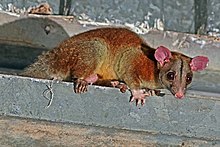 더비의 털실 오포섬, 칼로미스 데르비누스
더비의 털실 오포섬, 칼로미스 데르비누스- 서브게너스 칼로미스
- 맨꼬리양털오피스움(Caluromys pilander)
- 서브게너스 말로델피스
- 더비의 털실 오포섬 (Caluromys derbianus)
- 갈색귀양털오피스움(Caluromys lanatus)
- 서브게너스 칼로미스
- 칼로미솝스속
- 검은 어깨 오포섬(Caluromysiops irrupta)
- 칼로미스속
- 하이라델피나과
- 힐라델피스속
- 칼리노프스키의 생쥐 오포섬(Hyladelphys 칼리노프스키i)
- 힐라델피스속
- 디델피나과
- 메타치리니 부족
 갈색네눈주머니쥐,메타키루스누디카투스
갈색네눈주머니쥐,메타키루스누디카투스- 메타키루스속
- 기아난갈색 네눈주머니쥐(메타키루스 누디카우두투스)
- 통갈색 네눈주머니쥐(메타키루스묘스로스)
- 메타키루스속
- 디델피니 일족
 물주머니쥐, 치로넥테스 미니무스
물주머니쥐, 치로넥테스 미니무스- 키로넥테스속
- 이름없는 부분군
- 루트렐리나속
- † 루트레올리나 비포라타[17]
- 큰 루트린 오포슘 또는 작은 물 오포섬(Lutreolina crassicaudata)
 큰루트린오포섬,루트렐리나크라시카우다타
큰루트린오포섬,루트렐리나크라시카우다타 - 뤼트레올리나 마테르데이[82]
- 마스소아의 루트린 오포섬(루트레올리나 마스소아)[83]
- †게누스 하이퍼디델피스
- 루트렐리나속
- 이름없는 부분군
- 디델피스속
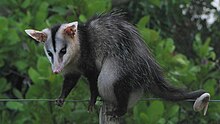 흰귀주머니쥐, 디델피스 알비벤트리스큰귀주머니쥐, 디델피스오리타
흰귀주머니쥐, 디델피스 알비벤트리스큰귀주머니쥐, 디델피스오리타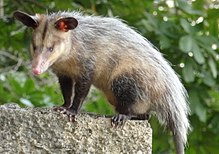 코뿔소, 디델피스 말수피알리스
코뿔소, 디델피스 말수피알리스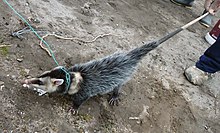 안데스 흰귀주머니쥐, 디델피스 페르니그라
안데스 흰귀주머니쥐, 디델피스 페르니그라 - 필란더속
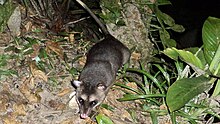 회색 네눈주머니쥐, 필란더주머니쥐
회색 네눈주머니쥐, 필란더주머니쥐- 앤더슨의 네눈주머니쥐(필란데르데르니)
- 흔한 네눈주머니쥐(필란더 카누스)
- 델타닉 네눈주머니쥐(필란더 델태)
- 남동쪽 네눈주머니쥐 (필란더 frenatus)
- 매킬로니의 네눈주머니(필란더 맥실레니)
- 짙은 네눈주머니쥐(필란더 멜라누루스)
- 몽돌피의 네눈주머니쥐 (필란더 몽돌피이)
- 검은 네눈주머니쥐 (필란더 니그라투스)
- 올록의 네눈주머니쥐 (필란더 올로기)
- 회색 네눈주머니쥐(필란더주머니쥐)
- 페바스 네눈주머니쥐(필란더 페바스)
- 북방네눈주머니쥐 (필란더보시)
- †게누스 틸로포롭스
- 디델피스속
- 마르모시니 일족
- 속스페로시누스속
- 마모사속
- 수브게누스 마르모사
 로빈슨 생쥐 오포섬, 마모사 로빈슨기
로빈슨 생쥐 오포섬, 마모사 로빈슨기- 중거미쥐포섬(마모사 안데르센디)
- 이스미안 생쥐 주머니쥐 (Marmosa isthmica)
- 루퍼스 생쥐 주머니쥐(마모사 레피다)
- 멕시코쥐 opossum (Marmosa mexicana)
- 리나에우스의 생쥐 주머니쥐 (마모사 무리나)
- 퀘추안 마우스 오포섬(마모사 키추아)
- 로빈슨 생쥐 오포섬 (마모사 로빈슨기)
- 붉은쥐주머니쥐(마모사 루브라)
- 시몬의 쥐 오포섬 (마모사 시몬시)
- 타일러의 쥐 주머니쥐 (마모사 타일러나)
- 워터하우스 쥐오피스움(마모사 워터하우스)
- 과히라쥐포섬(마모사 세로필라)
- 젤레돈의 쥐오피스움(마르모사 젤레도니)
- 아들러쥐목(Marmosa adleri)
- 수브게누스 미쿠레우스
- 알스톤의 털가죽 생쥐 주머니쥐 (마모사 알스토니)
- 흰배양털쥐오피스움(마모사 상수)
- 북동양털쥐목(마모사 데메라레)
- 노스웨스턴 울리쥐 opossum (Marmosa 게르마나)
- 잔사양털쥐오포섬(마모사잔새)
- 마르모사 라벤티카[85]
- 브라질 양털 생쥐 오포섬(마모사 리매)
- 메리다양털쥐오피스움(마모사경맥)
- 테이트의 털가죽 생쥐 오포섬(마모사 파라과이누스)
- 페루 양털 생쥐 오포섬(마모사 파르다)
- 앤소니의 털가죽 생쥐 opossum (Marmosa bluza)
- 작은 양털 생쥐 주머니쥐 (마모사 파에우스)
- 볼리비아양털쥐오피스움(마모사라포사)
- 맨꼬리양털쥐오피스움(마모사루테리)
- 수브게누스 마르모사
- 모노델피스속
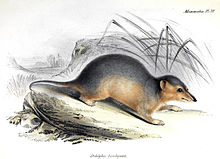 황면오피나무, 모노델피스디미디아타
황면오피나무, 모노델피스디미디아타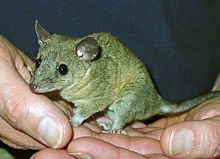 회색짧은꼬리주머니쥐목,모노델피스국내산
회색짧은꼬리주머니쥐목,모노델피스국내산- 세피아 짧은꼬리주머니쥐 (모노델피스 아두스타)
- 북부삼줄오목(모노델피스 아메리카나)
- 알린도의 짧은꼬리주머니쥐(모노델피스 알린도이)[86]
- 북부붉은편주머니쥐(모노델피스브레비카우다타)
- 황면주머니쥐(모노델피스디미디아타)
- 회색꼬리주머니쥐(모노델피스 국내산)
- 에밀리아의 짧은꼬리주머니쥐(모노델피스 에밀리아)
- 아마존 적면 오포슘(모노델피스 글리리나)
- 핸드리의 짧은 꼬리 오포섬 (모노델피스 핸드레이)[87]
- 이헤링의 세 줄 오포섬(모노델피스 이헤링기)
- 피그미 짧은꼬리주머니쥐(모노델피스쿤시)
- 마라조 짧은꼬리주머니쥐(모노델피스마락시나)
- 오스굿의 짧은꼬리주머니쥐 (모노델피스 오스구디)
- 후드가 달린 붉은 면의 오포섬(모노델피스 팔리올라타)
- 긴코꼬리주머니쥐(모노델피스피노키오)
- 레이그 오포섬 (모노델피스 레이지)
- 로날드 오포섬 (모노델피스 로날디)
- 밤줄무늬주머니쥐(모노델피스 루비다)
- 사키 짧은꼬리주머니쥐(모노델피스사키)
- 산타로사 짧은꼬리주머니쥐(모노델피스생태로새아과)[88]
- 긴코꼬리주머니쥐(모노델피스 스칼롭스)
- 남부붉은사이드오포슘(모노델피스소록스)
- 남부 세 줄의 오포섬(모노델피스 테레사)
- 투안 짧은꼬리주머니쥐(모노델피스투안)[86]
- 적색 세 줄무늬주머니쥐(모노델피스 탯리스트리아타)
- 원스트립 오포섬(모노델피스 유니스트리아타)
- 보스의 짧은꼬리주머니쥐(모노델피스보시)
- 속스파라쿠시누스속[13]
- †틸라테리듐속
- 트라쿠아친속[79]
- 발사스 회색 생쥐 주머니쥐(Tlacuatzin balasensis)
- 테후안테펙 회색 마우스 주머니쥐(Tlacuatzin canescens)
- 유카탄회색마우스주머니쥐(Tlacuatzin gaumeri)
- 트레스 마리아스 회색 마우스 주머니쥐(Tlacuatzin insularis)
- 북회색쥐목(Tlacuatzin sinaloae)
- 지골레스 게누스 지골레스
- 지골레스타테이
- 티라미니 일족
- 차코델피스속
- 차코안 피그미 오포섬(차코델피스 포모사)
- 크립토나누스속
- 아그리콜라의 포도상구균(크립토나누스 아그리콜라이)
- 차코안 그라실 오포슘(크립토나누스 차코엔시스)
- 과히바 그라실 오포섬 (크립토나누스과이배)
- † 배부른 그라쉬 오포섬(크립토나누스 이그니투스)
- 운두아비 그라실 오포슘 (크립토나누스 운두아비엔시스)
- 그레이시리나누스속
- 아케라마르카 그라실 오포섬(그라키리나누스 아케라마르카에)
- 민첩한 gracile opossum (Gracilinanus agilis)
- 목재 스프라이트 그라실 오포섬(그라키리나누스 드라이아스)
- 에밀리아의 포도상구균(그라키리나누스 에밀레아)
- 북부 그레이실 오포섬(그라키리나누스 마리카)
- 브라질 그레이실 오포섬(그라키리나누스 마이크로타르수스)
- 페루 오포섬(그라키리나누스 페루아누스)
- 레스토델피스속
- 파타고니아 오포섬(Estodelphys Halli)
- 마모솝스속
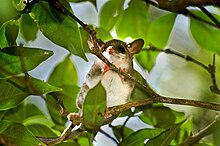 회색 가느다란 오포슘, 마모솝스 잉카누스
회색 가느다란 오포슘, 마모솝스 잉카누스- 비숍의 가느다란 오포섬(마모솝스 비숍이)
- 카의 가느다란 오포섬 (마모솝 까리)
- 코딜레라 호리호리한 오포슘(마모솝 츄차)
- 좁은머리의 호리호리한주머니쥐(마모소프 크랙센스)
- 크리톤 가느다란 오포섬(마모솝스 크리코니)
- 도로시의 가느다란 주머니쥐(마모솝스 도로테아)
- 칙칙한 가느다란 오포섬(마모솝스 퓨리아투스)
- 핸들리의 가느다란 오포섬(마모솝스 핸들리)
- 츠추디의 가느다란 주머니쥐 (마모솝스 임파비두스)
- 회색 가느다란 오포슘(마모솝스 잉카누스)
- 파나마 호리호리한 오포슘(마모솝스 인빅투스)
- 주닌 호리호리한 오포슘(마모솝스 쥬니넨시스)
- 리오 막달레나 호리호리한 오포섬(마모솝스 막달레나)
- 실바의 가느다란 오포섬(마모솝스 마리나)
- 네블리나 가는주머니쥐(마모솝스네블리나)
- 흰배 가느다란 오포슘(마모솝스 녹티바거스)
- 오자스티의 가느다란 오포섬(마모솝스 오자스티)
- 판테푸이 가느다란 오포슘(마모솝 파카라이메아)
- 섬세한 가느다란 오포슘(마모솝 파르비덴스)
- 브라질 호리호리한 오포슘(마모솝스 파울렌시스)
- 핀헤이로의 가느다란 오포섬(마모솝스 핀헤이로이)
- 소이니의 가느다란 오포섬(마모솝소이니)
- 우달의 가느다란 오포섬(마모솝 우달리)
- 티라미스속
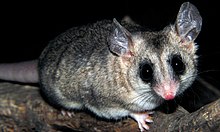 우아한 지방꼬리쥐오피스움, 티릴미 엘레건
우아한 지방꼬리쥐오피스움, 티릴미 엘레건- † 테일라미스 콜롬비아인비아누스[85]
- 신데렐라 뚱뚱한꼬리쥐포섬(Tylamys 신데렐라)
- 메소포타미아 지방꼬리쥐목(Tylamys citellus)[89]
- 우아한 지방꼬리쥐주머니쥐(Tylamys elegans)
- 카리미의 살찐꼬리쥐주머니쥐(Tylamys carimii)
- 파라과이 지방꼬리쥐주머니쥐(Tylamys macrurus)
- †Tylamys minutus[85]
- 흰배살꼬리쥐오피스움(Tylamys pallidior)
- 마른 차코 살코꼬리쥐주머니쥐(Tylamys pulchellus)[90]
- †타일라미스 파인니[91]
- 차코안 지방꼬리쥐오피스움(틸라미스푸스균)
- 아르헨티나 뚱뚱한꼬리쥐포섬(Tylamys sposerius)
- 테이트의 살찐 꼬리 생쥐 오포섬 (Tylamys tatei)
- 왜소지방꼬리쥐오피스움(Tylamys velutinus)
- 완충성 지방꼬리쥐목(Tylamys venustus)
- †Tylamyszetti[92]
- 차코델피스속
- 메타치리니 부족
- 사이라델피스속
참조
- ^ Goin, Francisco; Abello, Alejandra; Bellosi, Eduardo; Kay, Richard; Madden, Richard; Carlini, Alfredo (2007). "Los Metatheria sudamericanos de comienzos del Neógeno (Mioceno Temprano, Edad-mamífero Colhuehuapense). Parte I: Introducción, Didelphimorphia y Sparassodonta". Ameghiniana. 44 (1): 29–71.
- ^ Gardner, A. (2005). Wilson, D.E.; Reeder, D.M. (eds.). Mammal Species of the World: A Taxonomic and Geographic Reference (3rd ed.). Johns Hopkins University Press. pp. 3–18. ISBN 978-0-8018-8221-0. OCLC 62265494.
- ^ "Opossums". National Geographic. Retrieved September 21, 2018.
- ^ Mithun, Marianne (2001). The Languages of Native North America. Cambridge University Press. p. 332. ISBN 978-0-521-29875-9.
- ^ Crawford, James Mack; Crawford, James D. (1975). Studies in Southeastern Indian Languages. University of Georgia Press. ISBN 978-0-8203-0334-5.
- ^ a b c Siebert, Jr., Frank T. (1975). "Resurrecting Virginia Algonquian from the Dead: The Reconstituted and Historical Phonology of Powhatan". In Crawford, James Mack (ed.). Studies in Southeastern Indian Languages. University of Georgia Press.
- ^ "possum". The American Heritage Dictionary of the English Language, Fifth Edition. Houghton Mifflin Harcourt. 2014. Retrieved 12 July 2014.
- ^ "Didelphimorphia". Wordnik. Retrieved 21 February 2017.
- ^ a b c d 크라우스, 윌리엄 J; 크라우스, 위니프레드 A. (2006)오포섬: 놀라운 이야기 웨이백 머신에 2012-12-11로 보관.미주리, 컬럼비아, 미주리 대학 병리학 및 해부학 과학부. 페이지 39
- ^ Crompton, A. W.; Hiiemae, Karen (February 1970). "Molar occlusion and mandibular movements during occlusion in the American opossum, Didelphis marsupialis L." Zoological Journal of the Linnean Society. 49 (1): 21–47. doi:10.1111/j.1096-3642.1970.tb00728.x.
- ^ Goin, Francisco; Abello, Alejandra; Bellosi, Eduardo; Kay, Richard; Madden, Richard; Carlini, Alfredo (2007). "Los Metatheria sudamericanos de comienzos del Neógeno (Mioceno Temprano, Edad-mamífero Colhuehuapense). Parte I: Introducción, Didelphimorphia y Sparassodonta". Ameghiniana. 44 (1): 29–71.
- ^ a b Jansa, Sharon A.; Barker, F. Keith; Voss, Robert S. (March 2014). "The Early Diversification History of Didelphid Marsupials: A Window into South America's "splendid Isolation"". Evolution. 68 (3): 684–695. doi:10.1111/evo.12290. PMID 24125654. S2CID 10274949.
- ^ a b c Beck, Robin M. D.; Taglioretti, Matias L. (2019). "A Nearly Complete Juvenile Skull of the Marsupial Sparassocynus derivatus from the Pliocene of Argentina, the Affinities of "Sparassocynids", and the Diversification of Opossums (Marsupialia; Didelphimorphia; Didelphidae)". Journal of Mammalian Evolution. 27 (3): 385–417. doi:10.1007/s10914-019-09471-y. S2CID 198190603.
- ^ a b Engelman, Russell K.; Anaya, Federico; Croft, Darin A. (9 November 2016). "New palaeothentid marsupials (Paucituberculata) from the middle Miocene of Quebrada Honda, Bolivia, and their implications for the palaeoecology, decline and extinction of the Palaeothentoidea". Journal of Systematic Palaeontology. 15 (10): 787–820. doi:10.1080/14772019.2016.1240112. S2CID 88758358.
- ^ a b Engelman, Russell K.; Croft, Darin A. (6 May 2014). "A new species of small-bodied sparassodont (Mammalia, Metatheria) from the middle Miocene locality of Quebrada Honda, Bolivia". Journal of Vertebrate Paleontology. 34 (3): 672–688. doi:10.1080/02724634.2013.827118. S2CID 84680371.
- ^ a b Engelman, Russell K.; Anaya, Federico; Croft, Darin A. (27 June 2018). "Australogale leptognathus, gen. et sp. nov., a Second Species of Small Sparassodont (Mammalia: Metatheria) from the Middle Miocene Locality of Quebrada Honda, Bolivia". Journal of Mammalian Evolution. 27 (1): 37–54. doi:10.1007/s10914-018-9443-z. S2CID 49473591.
- ^ a b c d e f g h Goin, Francisco J.; Pardinas, Ulyses F. J. (1996). "Revision de las especies del genero Hyperdidelphys Ameghino, 1904 (Mammalia, Marsupialia, Didelphidae. Su significacion filogenetica, estratigrafica y adaptativa en el Neogeno del Cono Sur sudamericano". Estudios Geologicos. 52 (5–6): 327–359. doi:10.3989/egeol.96525-6275.
- ^ Martinelli, P.M.; Nogueira, J.C. (1997). "Penis morphology as a distinctive character of the murine opossum group (Marsupialia Didelphidae): A preliminary report". Mammalia. 61 (2). doi:10.1515/mamm.1997.61.2.161. S2CID 84674547.
- ^ De Barros, M. A.; Panattoni Martins, J. F.; Samoto, V. Y.; Oliveira, V. C.; Gonçalves, N.; Mançanares, C. A.; Vidane, A.; Carvalho, A. F.; Ambrósio, C. E.; Miglino, M. A. (2013). "Marsupial morphology of reproduction: South America opossum male model" (PDF). Microscopy Research and Technique. 76 (4): 388–97. doi:10.1002/jemt.22178. PMID 23362127. S2CID 27200317.
- ^ Vieira, Emerson R.; De Moraes, D. Astua (2003). "Carnivory and insectivory in Neotropical marsupials". Predators with Pouches: the biology of carnivorous marsupials. Csiro Publishing. pp. 267–280. ISBN 978-0-643-06634-2.
- ^ Marshall, Larry G. (1978). "Chironectes minimus". Mammalian Species. 109 (99): 1–6. doi:10.2307/3504051. JSTOR 3504051.
- ^ a b Goin, Francisco J.; Natalia Zimicz; Martin de los Reyes; Leopoldo Soibelzon (2009). "A new large didelphid of the genus Thylophorops (Mammalia: Didelphimorphia: Didelphidae), from the late Tertiary of the Pampean Region (Argentina)". Zootaxa. 2005: 35–46. doi:10.11646/zootaxa.2005.1.3.
- ^ Prevosti, Francisco J.; Forasiepi, Analía; Zimicz, Natalia (2011). "The Evolution of the Cenozoic Terrestrial Mammalian Predator Guild in South America: Competition or Replacement?". Journal of Mammalian Evolution. 20: 3–21. doi:10.1007/s10914-011-9175-9. S2CID 15751319.
- ^ Cenizo, Marcos; Soibelzon, Esteban; Magnussen Saffer, Mariano (2015). "Mammalian predator–prey relationships and reoccupation of burrows in the Pliocene of the Pampean Region (Argentina): New ichnological and taphonomic evidence". Historical Biology. 28 (8): 1026–1040. doi:10.1080/08912963.2015.1089868. S2CID 83862150.
- ^ Flores, David A. (2009). "Phylogenetic analysis of postcranial skeletal morphology in didelphid marsupials". Bulletin of the American Museum of Natural History. 320: 1–81. doi:10.1206/320.1. hdl:2246/5953. S2CID 54177473.
- ^ Gardner, Alfred. Mammals of South America Volume 1. University of Chicago Press. p. 34.
- ^ 캠벨, N. & Rece, J. (2005) 생물학.피어슨 교육 주식회사
- ^ 재생 – 라이프 사이클. opossumsocietyus.org.
- ^ Enders, A.C. & Enders, R.K. (2005). "The placenta of the four-eyed opossum (Philander opossum)". The Anatomical Record. 165 (3): 431–439. doi:10.1002/ar.1091650311. PMID 5346723. S2CID 85011250.
- ^ Krause, W.J. & Cutts, H. (1985). "Placentation in the Opossum, Didelphis virginiana". Acta Anatomica. 123 (3): 156–171. doi:10.1159/000146058. PMID 4061035.
- ^ O'Connell, Margaret A. (1984). Macdonald, D. (ed.). The Encyclopedia of Mammals. New York: Facts on File. pp. 830–837. ISBN 978-0-87196-871-5.
- ^ "Opossums National Geographic". Animals. 11 November 2010.
- ^ Mellor, D. J.; Lentle, R. G. (2015). "Survival implications of the development of behavioral responsiveness and awareness in different groups of mammalian young". New Zealand Veterinary Journal. 63 (3): 131–40. doi:10.1080/00480169.2014.969349. PMID 25266360. S2CID 24045688.
- ^ a b 버지니아 오포섬 디델피스 버진티아나스미스소니언 국립 자연사 박물관.
- ^ 오포섬 팩트.opossum.org.
- ^ "Possum Hunt". Archived from the original on 2013-11-10.
- ^ Moore, H.D. (1996). "Gamete biology of the new world marsupial, the grey short-tailed opossum, monodelphis domestica". Reproduction, Fertility, and Development. 8 (4): 605–15. doi:10.1071/RD9960605. PMID 8870084.
- ^ Hamilton, W. J., Jr. (1958). "Life history and economic relations of the opossum (Didelphis marsupialis virginiana) in New York State". Cornell Univ. Agric. Exp. Sta. Memoirs. 354: 1–48.
{{cite journal}}: CS1 maint : 복수이름 : 작성자 목록(링크) - ^ "Opossums – Living with Wildlife Washington Department of Fish & Wildlife". wdfw.wa.gov. Retrieved 2017-05-14.
- ^ 고아가 되거나 다친 오포섬을 찾으셨나요?Opossumsocietyus.org.2012-05-03년에 검색됨.
- ^ González, E.M.; Claramunt, S. (2000). "Behaviors of captive short-tailed Opossums, Monodelphis dimidiata (Wagner, 1847) (Didelphimorphia, Didelphidae)". Mammalia. 64 (3). doi:10.1515/mamm.2000.64.3.271. S2CID 84782113.
- ^ "Opossum Sounds & Noises: What Do Opossums Sound Like?". www.crittercontrol.com. Retrieved 2022-01-24.
- ^ "What Do Possums Eat? Facts About Their Diet Terminix". Terminix.com. Retrieved 2020-05-29.
- ^ Voss, Robert S.; Jansa, Sharon A. (November 2012). "Snake-venom resistance as a mammalian trophic adaptation: lessons from didelphid marsupials". Biological Reviews. 87 (4): 822–837. doi:10.1111/j.1469-185X.2012.00222.x. PMID 22404916. S2CID 21264310.
- ^ Perales, Jonas; Moussatché, Haity; Marangoni, Sergio; Oliveira, Benedito; Domont, Gilberto B. (October 1994). "Isolation and partial characterization of an anti-bothropic complex from the serum of South American Didelphidae". Toxicon. 32 (10): 1237–1249. doi:10.1016/0041-0101(94)90353-0. PMID 7846694.
- ^ a b Voss, Robert S. (May 2013). "Opossums (Mammalia: Didelphidae) in the diets of Neotropical pitvipers (Serpentes: Crotalinae): Evidence for alternative coevolutionary outcomes?". Toxicon. 66: 1–6. doi:10.1016/j.toxicon.2013.01.013. PMID 23402839.
- ^ Kirchner, Jane (13 June 2017). "Opossums: Unsung Heroes in the Fight Against Ticks and Lyme Disease". National Wildlife Federation. Retrieved 26 August 2019.
- ^ "Oops! Opossums Don't Actually Eat Ticks". For Foxs Sake Wildlife. 29 July 2021. Retrieved 18 January 2021.
- ^ Hennessy, Cecilia; Hild, Kaitlyn (15 July 2021). "Are Virginia opossums really ecological traps for ticks? Groundtruthing laboratory observations". National Library of Medicine, National Center for Biotechnology Information. Retrieved 18 January 2021.
- ^ Gardner, A.L.; Sunquist, M.E. (2003). "Opossum: Didelphis virginiana". In Feldhamer, G.A.; Thompson, B.C.; Chapman, J.A. (eds.). Wild Mammals of North America: Biology, Management, and Conservation. JHU Press. pp. 3–29. ISBN 978-0-8018-7416-1.
- ^ "opossum marsupial". Encyclopedia Britannica. Retrieved 2017-04-03.
- ^ "Virginia Opossum – Didelphis virginiana – NatureWorks". www.nhptv.org. Retrieved 2017-04-03.
- ^ "Animals in the Temperate Rainforest Biome". Sciencing. Retrieved 2021-05-18.
- ^ "Maine's marsupials: Opossums continue to move north". Bangor Daily News. 2012-10-26.
- ^ 서튼, 키스 (2009년 1월 12일) 주머니쥐 시절은 지났다.ESPN 아웃도어.
- ^ 와일드 게임 레시피 온라인.2009년 12월 29일 발견
- ^ 파월, 보니 아자브(2006-10-14)'요리의 즐거움'의 기쁨은 1962년경 웨이백머신에 보관된 2006-10-30ethicurean.com.
- ^ Apicius (2012). Cookery and Dining in Imperial Rome. Courier Corporation. pp. 205–. ISBN 978-0-486-15649-1.
- ^ McNulty, Timothy (September 6, 1978). "Possums Are His Passion". The Evening Independent.
- ^ "'Possum Man' is Mayor". The Hour. September 29, 1978.
- ^ Moser, Mike (August 6, 2004). "King of the possums is dead". Crossville Chronicle.
- ^ Jones, Evan (2007). American Food: The Gastronomic Story. Overlook Press. ISBN 978-1-58567-904-1.
- ^ "Possum Recipes". 11 November 1999. Archived from the original on 11 November 1999.
- ^ "Over 'Possums Comes A Clash". Atlanta Constitution. February 4, 1909. Retrieved July 19, 2020.
- ^ History of Worth County, Georgia: For the First Eighty Years, 18-54-1934. J.W. Burke Company. 1934. pp. 83–84.
- ^ "Cooking a Possum". 9 November 1999. Archived from the original on 9 November 1999.
- ^ Carter, Jimmy (1995). Always a Reckoning, and Other Poems. Times Books. pp. 39–. ISBN 978-0-8129-2434-3.
- ^ Raum, Elizabeth (13 September 2011). Gift of Peace: The Jimmy Carter Story: The Jimmy Carter Story. Zonderkidz. pp. 15–. ISBN 978-0-310-72757-6.
- ^ "President Jimmy Carter Inducted into Georgia Hunting and Fishing Hall of Fame".
- ^ Doolittle, Leslie (February 11, 2001). "Carter Shares Times". Orlando Sentinel.
- ^
- Twain, Mark; Warner, Charles Dudley (1904). The Writings of Mark Twain [pseud.].: A tramp abroad. Harper & Bros. pp. 263–.
- "Mark Twain's Rapturous List of His Favorite American Foods". 2 March 2012.
- "A little bill of fare". listsofnote.com. 2 March 2012.
- Clemens, Samuel Langhorne (1907). The Writings of Mark Twain [pseud.]. Harper. pp. 263–.
- Warner, Charles Dudley (1907). The Writings of Mark Twain [pseud.]: A tramp abroad. Harper & brothers. pp. 263–.
- Twain, Mark (27 October 2010). Mark Twain's Library of Humor. Random House Publishing Group. pp. 200–. ISBN 978-0-307-76542-0.
- Twain, Mark (1901). A tramp abroad. American Publishing Company. pp. 263–.
- Twain, Mark (18 October 2004). Mark Twain's Helpful Hints for Good Living: A Handbook for the Damned Human Race. University of California Press. pp. 66–. ISBN 978-0-520-93134-3.
- Howells, William Dean (1888). Mark Twain's Library of Humor. Charles L. Webster & Company. pp. 232–.
- DiGregorio, Sarah (6 July 2010). "Mark Twain Eats America". villagevoice.com.
- Walker Linsenmeyer, Helen; Kraig, Bruce (2011). Cooking Plain, Illinois Country Style. SIU Press. pp. 7–. ISBN 978-0-8093-3074-4.
- ^ "Southern Caribbean: Islands of Martinique, Dominica, Grenada, Saint Lucia, Saint Vincent and the Grenadines Ecoregions WWF". World Wildlife Fund. Retrieved 2017-05-14.
- ^ "tlacuache". Biblioteca Digital de la Medicina Tradicional Mexicana (in Spanish). Biblioteca Digital de la Medicina Tradicional Mexicana.
- ^ Worley, Paul M. (2013). Telling and Being Told: Storytelling and Cultural Control in Contemporary Yucatec Maya Literatures. University of Arizona Press. ISBN 9780816530267 – via Google Books.
- ^ Silva, Andréa Leme da (2008). "Animais medicinais: Conhecimento e uso entre as populações ribeirinhas do rio Negro, Amazonas, Brasil". Boletim do Museu Paraense Emílio Goeldi. Ciências Humanas. 3 (3): 343–357. doi:10.1590/S1981-81222008000300005.
- ^ Pinto, Angélica Auxiliadora da Costa; Maduro, Cice Batalha (2003). "Produtos e subprodutos da medicina popular comercializados na cidade de Boa Vista, Roraima". Acta Amazonica. 33 (2): 281–290. doi:10.1590/1809-4392200332290.
- ^ Barros, Flávio B.; Varela, Susana AM; Pereira, Henrique M.; Vicente, Luís (2012). "Medicinal use of fauna by a traditional community in the Brazilian Amazonia". Journal of Ethnobiology and Ethnomedicine. 8: 37. doi:10.1186/1746-4269-8-37. PMC 3502351. PMID 23013927.
- ^ Upham, Nathan S.; Esselstyn, Jacob A.; Jetz, Walter (2019). "Inferring the mammal tree: Species-level sets of phylogenies for questions in ecology, evolution and conservation". PLOS Biol. 17 (12): e3000494. doi:10.1371/journal.pbio.3000494. PMC 6892540. PMID 31800571.
- ^ a b Voss, Robert S.; Jansa, Sharon A. (2009). "Phylogenetic relationships and classification of didelphid marsupials, an extant radiation of New World metatherian mammals". Bulletin of the American Museum of Natural History. 322: 1–177. doi:10.1206/322.1. hdl:2246/5975. S2CID 85017821.
- ^ Database, Mammal Diversity (2021-08-10), Mammal Diversity Database, Zenodo, retrieved 2021-11-06
- ^ McClure, Sonny R. "New opossum species named after UWO biologist Greg Adler". www.abigailgroff.com. Retrieved 2021-12-13.
- ^ Goin, Francisco J.; de los Reyes, Martin (2011). "Contribution to the knowledge of living representatives of the genus Lutreolina Thomas, 1910 (Mammalia, Marsupialia, Didelphidae)". Historia Natural. 1 (2): 15–25. JSTOR 20627135.
- ^ Martínez-Lanfranco, Juan A.; Flores, David; Jayat, J. Pablo; d'Elía, Guillermo (2014). "A new species of lutrine opossum, genus Lutreolina Thomas (Didelphidae), from the South American Yungas". Journal of Mammalogy. 95 (2): 225. doi:10.1644/13-MAMM-A-246. S2CID 85599660.
- ^ Cozzuol, Mario A.; Goin, Francisco J.; de los Reyes, Martin; Ranzi, Alceu (2006). "The oldest species of Didelphis (Mammalia, Marsupialia, Didelphidae) from the late Miocene of Amazonia". Journal of Mammalogy. 87 (4): 663–667. doi:10.1644/05-MAMM-A-282R2.1. S2CID 85646145.
- ^ a b c Goin, Francisco J. (1997). "New clues for understanding Neogene marsupial radiations". Vertebrate Paleontology of the Miocene in Colombia. A History of the Neotropical Fauna. Smithsonian Institution Scholarly Press. pp. 185–204. ISBN 978-1-56098-418-4.
- ^ a b Pavan, Silvia Eliza; Rossi, Rogerio Vieira; Schneider, Horacio (2012). "Species diversity in the Monodelphis brevicaudata complex (Didelphimorphia: Didelphidae) inferred from molecular and morphological data, with the description of a new species". Zoological Journal of the Linnean Society. 165: 190–223. doi:10.1111/j.1096-3642.2011.00791.x.
- ^ 솔라리, S. (2016).모노델피스 핸드레이.IUCN 멸종 위기 종 목록 doi:10.2305/IUCN.UK.2016-3.RLTS.T199833A22171921.
- ^ Voss, Robert S.; Pine, Ronald H.; Solari, Sergio (2012). "A New Species of the Didelphid Marsupial Genus Monodelphis from Eastern Bolivia". American Museum Novitates. 3740 (3740): 1. doi:10.1206/3740.2. S2CID 83545414.
- ^ 플로레스, D. & 테타, P. (2016)티라미 시텔루스IUCN 멸종 위기 종 목록 doi:10.2305/IUCN.UK.2016-2.RLTS.T199835A22172943.
- ^ 플로레스, D. & 테타, P. (2016)타일라미 풀켈루스.IUCN 멸종 위기 종 목록 doi:10.2305/IUCN.UK.2016-2.RLTS.T199834A22172571.
- ^ Goin, Francisco J.; Montalvo, C.I.; Visconti, G. (2000). "Los marsupiales (Mammalia) del Mioceno Superior de la Formacion Cerro Azul (Provincia de La Pampa, Argentina)". Estudios Geologicos. 56 (1–2): 101–126. doi:10.3989/egeol.00561-2158.
- ^ Goin, Francisco J. (1997). "Thylamys zettii, nueva especie de marmosino (Marsupialia, Didelphidae) del Cenozoico tardio de la region Pampeana". Ameghiniana. 34 (4): 481–484.
외부 링크
| 위키미디어 커먼즈에는 디델피디아와 오포섬과 관련된 미디어가 예술에 있다. |
| 무료 사전인 Wiktionary에서 오보섬을 찾아 보십시오. |
| 위키피아는 디델피디아와 관련된 정보를 가지고 있다. |
- "소유 아니면 오포섬?"—뉴질랜드 박물관 테 파파 통가레와에."
- UCSC 게놈 브라우저에서 monDom5 게놈 어셈블리를 보십시오.


























